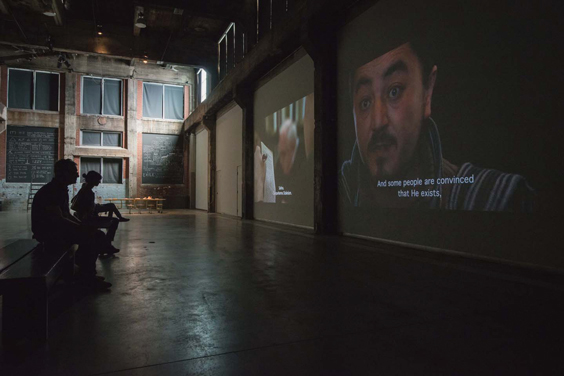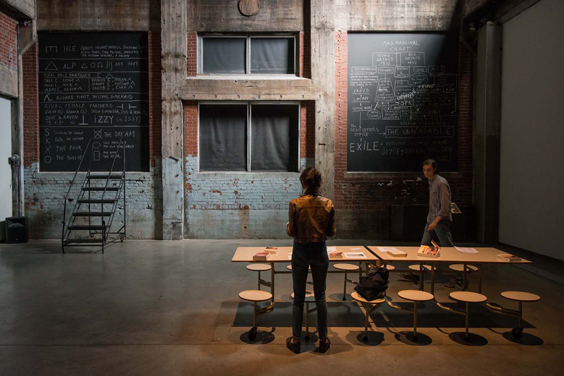
Dora Garcia, Of Crimes and Dreams, exhibition view at Darling Foundry 2014. Courtesy Darling Foundry, Montréal. Photo © Maxime Boisvert
Dora García
Of Crimes and Dreams
Darling Foundry, Montréal
21 May – 14 September 2014
Review by Cécilia Bracmort
Of Crimes and Dreams strips the threshold between reality and fantasy where the two worlds interpenetrate and nourish each other. Upon entering Dora García’s exhibition curated by Chantal Pontbriand, one figuratively experiences a journey into the human psyche and all its complex richness, sequences of altered states and perceptions from waking life to unconsciousness, assisted by García’s use of Finnegans Wake, James Joyce’s last and most experimental novel.
Three videos works projected on the walls of the gallery underline recurrent visual and structural patterns such as circle overlays and echoing effects. Indeed, all videos mirror Joyce’s narrative structure, a never-ending novel, starting and finishing through reconstituted sentences. These seemingly aim to trigger different psychological desires from sexual or voyeuristic desires to the repression of violence or even murderous pulsions.
Two of the projected videos are disposed side by side and take up two large parts of the main gallery wall, as huge cinema screens. These are presenting two different groups of people sitting together, engaged in discussions about Joyce’s novel. The wobbly shots emphasize an amateurish hand-held filming technique, particularly so with the numerous close-ups. The separate soundtracks for each video – only accessible via double channels headphones – reveal details of the group discussions, giving viewers more insight to García’s works.
The former projection, entitled Désordre, located on the right hand side of the wall, sees a first discussion recorded at Montperrin – a psychiatric hospital in the South of France. Tellingly from the contrasting verbal and body language, individuals in this group stem from varied social and ethnic backgrounds, to discuss emotions and themes in Joyce’s book such as betrayal, desire and faith. Contrarily to the seriousness of the topic, the tone of this video is surprisingly joyful. The group reveals a richness of individual & collective imagination. Responding to the question “Do you think anybody can be a murderer?”, the group jokes and shares personal dream experiences to tentatively outline “universal thoughts” and common fears on the limits of dreams and reality. The latter projection on the left meanwhile presents The Joycean Society; a literary focus group gathered to here again discuss Finnegans Wake, leading to numerous interpretations, allegedly spending hours, days and years to decipher the novel’s complex narrative. We even find the group taking more than a decade to finish its final “lap” of reading. Here again, close-ups reveal psychological aspects of individual members and their relationship to the book; the thoroughness of their endeavor to understand Joyce’s words revealing a strong sense of humour, particularly when finding saucy passages.

Dora García, The Joycean Society, 2012 HD Video still © Dora García. Courtesy Prince Pierre of Monaco Foundation. Via Universes-in-Universe
Alongside the videos, García’s installations emphasize the loose connections between vision and perception, leading her to explore Lacanian theories focused on the three orders of Ego. For instance, Mad Marginal Charts finish our journey through the exhibition, with two large blackboards naturally lit by the ambient light of the room. Full of inscriptions reminiscent of arcane philosophic formulas, the boards again reflect relations between psychoanalysis and art. While the inscriptions on the right gather quotes and themes developed by French dramaturge and theorist Antonin Artaud, renown for his Theatre of Cruelty, the other scribbles return to Finnegans Wake characters to substantiate their relationship as “susceptible to [endless] interpretation” to paraphrase Lacan. This way, the artist outlines the importance of such theories in her work, allowing to elaborate visions and perceptions of the ego, as with her final projection in the show: Hotel Wolfers. This is a homage to Beckett’s 1964 experimental movie, Film, and here García displays a black and white sequence displaying an abandoned hotel, while an off-screen narrator describes Beckett’s oeuvre. The formidable contrast between the ghostly presence of the building and the physical absence of the narrator impacts an interrelation between three orders of presentation: the imaginary, the symbolic and the real. Back to the blackboards, a long untidy table is stacking copies of Joyce’s celebrated novel to here allow visitors to read Finnegans Wake, deepen their own reflections on the complexity of the author’s literature as well as share opinions by leaving notes on sheets of paper also provided on the same table.
García wonderfully plays with the irrational and opaque qualities defining Joyce’s works by displaying his precursory thoughts that helped shape the post-structuralist and post-modern eras. With Of Crimes and Dreams García not only underlines the complexity of the human mind, but also reveals its compulsive beauty.
Cécilia Bracmort is a writer based in Montréal

Dora García, Mad Marginal Charts, Darling Foundry 2014 Courtesy Darling Foundry, Montreal. Photo © Maxime Boisvert
Dora García
Of Crimes and Dreams
21 May – 14 September 2014
Darling Foundry
745 rue Ottawa
Montreal, Québec
H3C 1R8
fonderiedarling.org
Opening Hours
Wednesday, Friday – Sunday: 12h00 – 19h00
Thursday: 12h00 – 22h00
Closed on Monday and Tuesday
